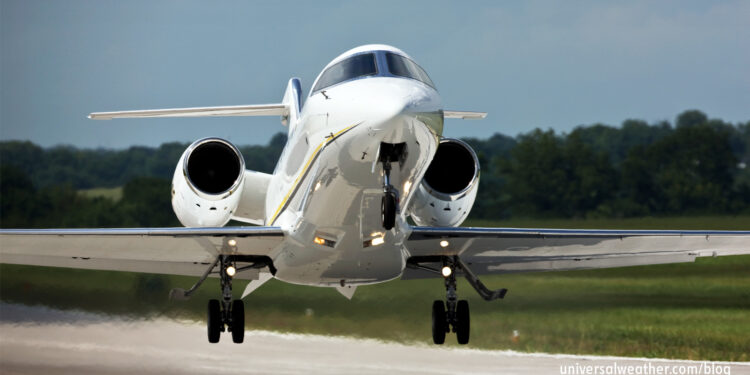Best Practice for EU-based Business Aircraft Operators Conducting International Trips

This is a post by author Adam Dowley. Adam is the Assistant Manager for the European Operations Centre based in Stansted. Adam is an expert on international operations for European-based business aviation operators and can be contacted at adamdowley@univ-wea.com.
For EU-based business aircraft operators flying worldwide, there are best practices to follow to ensure trips are conducted as smoothly as possible. Country of aircraft registration and base location do not generally present issues when operating internationally, as long as your aircraft is International Civil Aviation Organization state-registered, and all documentation is up to date. Permit and documentation requirements, however, are among the bigger challenges operators face. For this reason, it’s recommended that research be done in advance with both your 3rd-party provider and ground handler involved in the process.
The following is an overview of what you need to know:
1. Know documentation requirements
Be sure to have copies of all required documents and permits onboard – including insurance (with war risk coverage), aircraft airworthiness and registration in case authorities at your destinations want to see them. Ensure that all passengers and crew, when required, have appropriate visas. If flying to the US, be sure to have an up-to-date Transportation Security Administration Waiver, complete with crew and passenger details, as well as destinations you might fly to stateside.
2. Have all necessary overflight and landing permits
Overflight and landing permits are needed for many countries, as soon as you leave the EU. Your 3rd-party provider will need to have crew and passenger details – and, occasionally, business contact information at destination – to set up permits. Some countries require that flight routings be provided with permit requests, and these routings are subject to modification by the local Civil Aviation Authority. Political issues may limit your freedom of movement. For instance, Israeli-built or -registered aircraft and Israeli-stamped passports are often not welcome in many Middle Eastern countries.
3. Consider other issues
Ensure that your insurance includes a war risk clause and allows you to overfly countries that are considered at war or unstable. Be aware that, in event of technical and maintenance issues, you may not have easy access to repairs. For example, while much of the world has good original equipment manufacturer support, it may not be so easy to source technical support in more remote regions of Africa or the Far East. Be aware that some regions have limited or poor air traffic control services, and popular European-language communication on occasion may be non-existent. You may encounter weather issues not common in the EU – particularly in tropical regions subject to hurricanes/typhoons.
4. Keep fuel and credit issues top of mind
Carry aviation fuel cards, as well as consumer credit cards, as backup. Be sure to check on fuel availability and price, pre-departure. Be aware that fuel prices vary considerably among different fuel providers and when using different aviation fuel cards. At some locations – especially more remote locales not frequented by general aviation – credit for services may be an issue, and it may be necessary to pay in cash. However, with prior arrangements, your local ground handler will usually be able to extend credit for services rendered.
5. Consider potential issues in the permit process
Permit lead times and documentation requirements can be somewhat onerous at times, so it’s always best to begin making arrangements early. If you underestimate permit or local requirements, and don’t fully prepare, you may find yourself operating illegally, your operation may invalidate your insurance coverage, and you may be unable to reach your intended destination.
6. Know crew documentation requirements and best practices
It’s best for crew to have multiple passports so that one can be sent off for visas while the other is used for travel. At some locations, crew may be able to obtain visas on arrival. Such visas, however, are often limited to a few days with no possibility of extension. Always ensure that copies of your first-class medical certificates and ATP licenses are available in case local authorities request copies. Some locations worldwide, such as Cuzco (SPZO), require special pilot training in advance of operation, and you’ll need to meet these requirements. Be aware that even though you may be a U.S. Visa Waiver Program (VWP) signatory carrier, crew members will always need visas. VWP does not cover crew members.
7. Be aware of passenger documentation requirements
Ensure all passengers have valid visas and passports before boarding. Aircraft can be stopped on a taxiway and prevented from takeoff if destination customs/immigration has reason to suspect that not all passengers and crew members have valid visas. Be sure that passengers have evidence of required vaccinations when needed. A 10-day incubation period is required for yellow fever and, therefore, short-notice trips may not always be possible. Be aware of prohibited and restricted items. Bringing alcohol into many Middle Eastern countries is not possible, and any onboard pets or weapons will require prior arrangements.
8. Be aware of curfews and schedule change issues
Curfews exist at many international locations, and you may face operational noise restrictions or curfews. If passengers change schedule, be aware that this may infringe on curfew times. When permits and airport slots are involved, it’s always best to make schedule changes as early as possible.
9. Use a 3rd-party provider to smooth operational details
Using the services of a 3rd-party provider always takes the hassle and worry out of trip planning and execution. They’ll do the legwork, stay on top of the regulations, arrange your permits and have the contacts to get you the best options available at international locations.
Closing thoughts
The bigger the trip, the more time operators should spend on pre-trip planning. Using a pre-trip checklist can help for international operations. You can download one here. In addition, you can seek the experience of a 3rd-party provider and/or local ground handlers to help ensure your trip is as smooth as possible.
Questions?
If you have any questions about this article, contact me at adamdowley@univ-wea.com.




